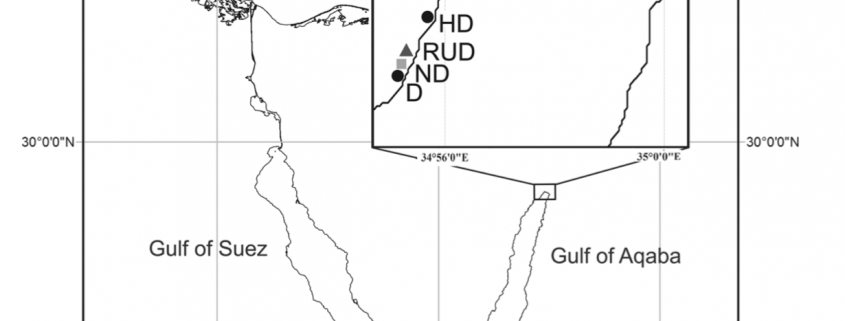“Boo! Did we scare you?”: behavioral responses of reef-associated fish, prawn gobies (Amblyeleotris steinitzi and Amblyeleotris sungami) to anthropogenic diver disturbance
By: Allison Banas, SRC Intern
There are many factors that can affect the health of coral reef communities, SCUBA diving being one of them. Studies have shown that divers’ activities can have significant detrimental effects on the ecosystem, and this paper from Valerio et al. (2018) looks at the effect divers can have on the behavior of two species of gobies.
The paper’s hypothesis is that divers in heavily dived areas have a habituating influence, along with causing a decreased latency period and a lower flight initiation distance (FID) on the gobies. This study took place at five sites along the Israeli coast of the Gulf of Eilat/Aqaba with differing levels of disturbance (Figure 1) Divers floated at least 3 m above the goby, and photographed the fish with a chosen scale object, and those gobies being disturbed were disturbed with a small weight attached to a nylon string wrapped around a pencil and lowered to land on the substrate approximately 15 cm in front of the goby. A timer was used to measure the latency period (time from disappearance to first reappearance), as soon as the goby retreated into its burrow. A seven-minute maximum time was pre-set.
Gobies in areas of high diver disturbance were found to no longer react to disturbances by having shorter latency periods, as well as shorter FID when compared to gobies at un-dived sites. Anthropogenic disturbance therefore is potentially leading to habituation of the gobies. The two different species of gobies were found to also have an effect on the data collecting, with A. sungami members having a significantly longer latency period than A. steinitzi, but this difference was found to be not significant. External factors including body size, circadian rhythm, depth and diving season were analyzed for significance, but none were found to have an effect on the latency periods.
This study opens the door for other studies to look at the potential effect of diver disturbance on the predation of gobies, since the gobies are spending less time in their burrows after a disturbance and have a shorter FID. If the same level of diver disturbance continues without rapidly habituating, the gobies could potentially spend a larger proportion of daylight hours in their burrows. Various statistical tests were completed in order to calculate potential diver effect, correlation between variables, average latency periods, and FID distances. In conclusion, diver disturbance has an effect on the behavior of gobies, and therefore the gobies have adapted their behavior.

Figure 1: A map showing the study sites along the coast of Eilat, Israel in the Gulf of Aqaba. (filled circle) Heavily dived (HD) and regularly dived (D); (light grey triangle) undived (UD); and relatively undived (RUD); and (light grey square) naturally disturbed (ND) [Dr. Gil Koplovitz]

Figure 2: Proportion of gobies that emerged over the 7-min time limit at each of the five sites. (Valerio et al. 2018)
Works cited
Valerio, M., Mann, O., & Shashar, N. (2019). “Boo! Did we scare you?”: behavioral responses of reef-associated fish, prawn gobies (Amblyeleotris steinitzi and Amblyeleotris sungami) to anthropogenic diver disturbance. Marine Biology, 166(1), 1.



